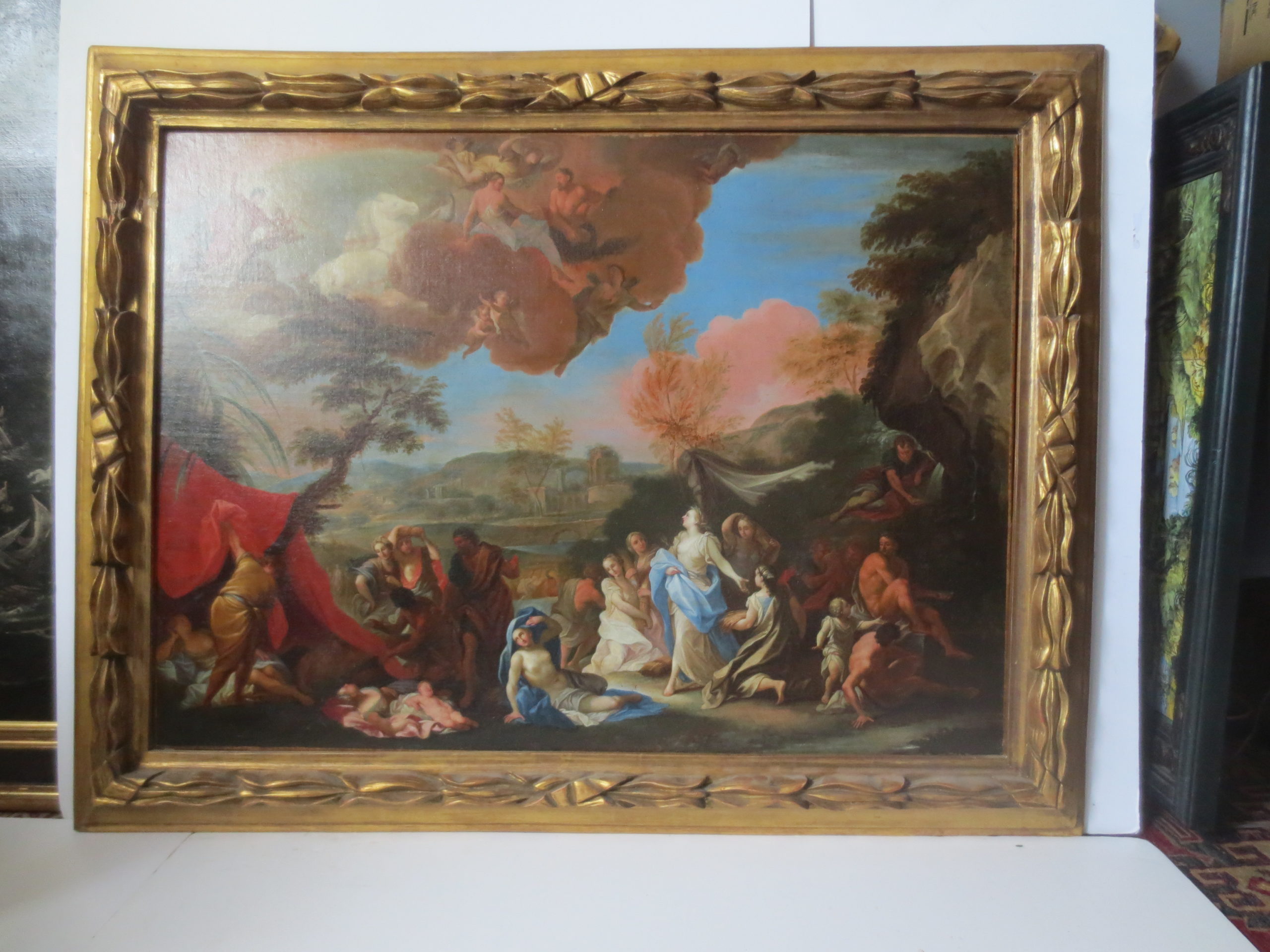Born in Palermo, Calandrucci was drawn early to the orbit of Carlo Maratta in Rome where, as probable pupil, possible assistant and defining follower he achieved wide-spread success providing altarpieces and large-scale fresco programs for church and noble clients. His rare oil paintings of secular subjects envisioned the Olympian gods and demi-gods in a pleasing narrative style that advanced Maratta’s application to Poussin’s formal classicism of Sacchi’s less stringent figuration and gentler coloring. Expanding on these models, Calandrucci’s own tastes ran to contrasts of more pastel tints set against or within darker passages in defining graceful movement and sweeter faces consonant with the Raphael revival current among the Italian elite in the latter decades of the seventeenth century.
Calandrucci’s composition of the Olympian gods was focused on the central dominant figure of Ceres, goddess of the grain which she holds with her acolyte as an offering to the heavenly deities of Jupiter and Juno, seated atop the heavens as Apollo drives Diana on a dark nocturnal cloud away from the emergent sunshine of morning. The composition is quite close to a painting of Ariadne and Bacchus in a Berlin private collection when it was published as Calandrucci by Hermann Voss, Die Malerei des Barock in Rom,Berlin,1924, illustrated p. 358. That attribution was suggested by Pascoli’s early reference to a painting of this rare subject by Calandrucci for an English patron (cf. Lione Pascoli, Vite de’ pittori, scultore, ed architetti moderni, 3 vols., Rome, 1730-1736, “Vite di Diacinto Calandrucci”, vol. 2, 1734, pp. 308 – 317, with the notice of an Ariadne and Bacchus, as well as mention of several other paintings and decorative projects utilizing mythological subjects in landscape and architectural settings, replete with numerous putti and ‘in altra diverse deità.’
While Calandrucci’s major altarpieces and frescos remain relatively inaccessible and only partially published, an invaluable color plate of his Apparizione della Virgine a san Fillipooffers numerous matches with his painting of the Olympian Pantheon. The compositional premise is similarly based on two tiers, the saint in center stage below looking up at the Virgin and Child on a bank of clouds, not unlike the relationship of Ceres to Jupiter in presenting the Christological gift of wheat. A curious result of the systematization of features in later Baroque model books, Ceres’ profile is seen again as an angelic cherub to the left of the hem of St. Phillip’s cope. Drapery is formed around long deep pleats, and backgrounds show discretely muted architectural references to Rome.
Two synoptic aspects common to both paintings demonstrate two specifics of Calandrucci’s habituated stylistic predilections. In each, clouds dominate the upper left, as they also do in the x-Berlin Ariadne and Bacchus; all are modeled with a full range of color from light pink crests to dark reddish-brown shadows below, their ethereal mass marked out by strands of reflected light edging around parts of clouds. Finally, Calandrucci’s coloring is rather distinctly his own, with predominant light yellows, pinks and pale blue greens that contrast and complement their darker kindred hues of rich reds and deep ultramarine blue. In this particular manner, the toggle between soft light tints and full-bodied colors generates a dramatic energy in both compositions almost apart from their median toned basic field,
Finally, the Olympian Pantheon and the x-Berlin Ariadne and Bacchus are near interchangeably alike in their entwined collation of figures arrayed along the frontal plane of the picture in a sequence of dark and light passages all in a row. Further, both share the same cast of stock figures, virtually identical in figure and facial types, details of peripheral staffage, landscape and architecture backdrop, and most important for a potential common commission, relatable themes drawn from the lives of the ancient gods and demi-gods. That concord might yet emerge as the key to a series intended for a post-Renaissance humanist studiolo, as hinted at in the variety of similar secular paintings commissioned from Calandrucci quite apart and pictorially unique from his major ceiling decorations and ecclesiastic altarpieces. This is a painting with an interesting probable past and an inchoate potential for an equally interesting future.
Pascoli’s biography is the fuller of two primary sources for the life and works of this artist and can be found in a modern edition of Pascoli’s complete works edited by Alessandro Marabottini et alia, Perugia, 1992; for Calandrucci’s vite, edited and copiously annotated by Maria Barbara Guerrieri Borsoi, pp. 747-756.Pascoli’s life of Calandrucci was also reprinted from the original printing with a German summary and annotations by Dieter Graf, Die Handzeichnungen von Giacinto Calandrucci, 2 vols., Dusseldorf, 1986,vol. 1, pp. 198-209. This fully illustrated and annotated publication of the large holding of Calandrucci drawings in Dusseldorf remains the best modern work on the artist.
More recently, Calandrucci’s relationship to his colleagues within Maratta’s wide sphere of influence is given attention in Costanza Costanzi, Marina Massa, et al, Il magistero di Carlo Maratti nella pitture marchigiani tra Sei e Settecento, Milan, 2011, p. 139 and an excellent color reproduction of the San Fillipo altarpiece on p. 137 pl. 6.

